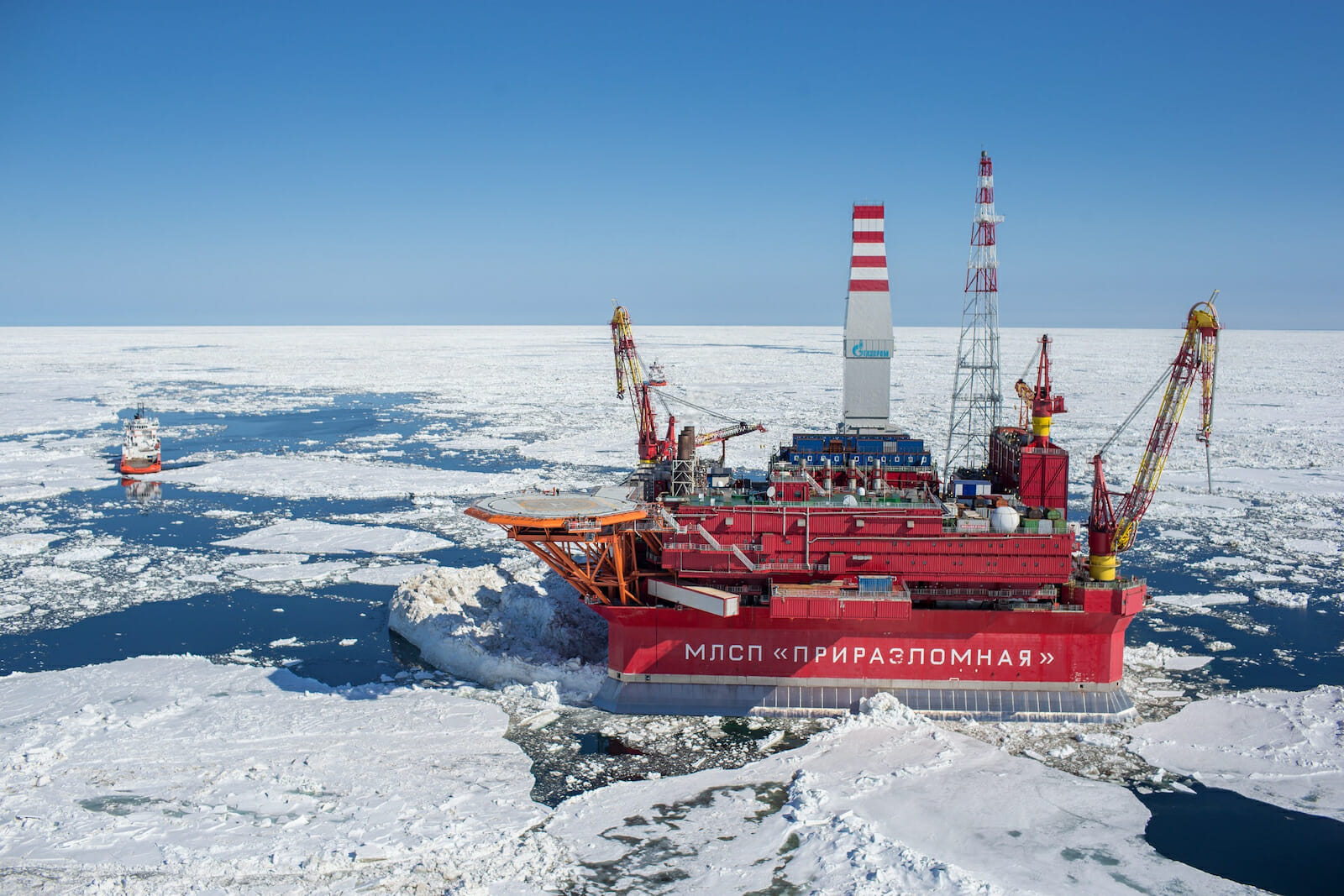
Global Warming can lead to Increased Global Energy Security
At the end of August, NASA delivered a statement, later confirmed by the American National Snow and Ice Data Centre (NSIDC), as well as the Norwegian Polar Institute (NPI), in which it stated that the extent of Arctic sea ice in 2012 has reached dramatically low levels. Since 1979, satellite recordings of the Arctic have provided valuable data on the annual variations of the region’s changing ice sheet.
The Arctic ice sheet is in constant motion. It grows during the cold Arctic winters and shrinks during the warmer periods reaching peak melt in mid-September. However, since the measurements began, a steady decline of 13 percent per decade has been noted. Additionally, alternative ways of measuring the extent of Arctic ice, such as sonar scans performed by submarines and seabed tethered buoys, have indicated to a drop in the thickness of the ice by over 40 percent compared to the levels recorded in the 1980s. Combining the loss in extent as well as in thickness, the total volume of Arctic ice is now a mere third of what it was in the 1980s.
There is a widespread consensus amongst the specialist in the organizations previously mentioned, that this process will accelerate even further during the coming years. The increased surface of open water lowers Earth’s reflectivity allowing for more heat to be trapped in the atmosphere, further accelerating the rise of ocean water temperature. This has not only an impact on the speed with which the ice melts but also on the increasing amount of released methane previously stored in the frozen seabed of the Arctic Ocean. Additionally, the increase in the size of open water, allows storms to generate larger waves which further break up the remaining ice sheet and accelerate its melt.
Though there is no consensus on the matter regarding a close approximation of the time that this will happen, scientist and experts do agree, however, that the Arctic will become ice-free by the end of this century. However, the main issue here is not whether the Arctic will be ice-free in ten years time, or in fifty. Rather, the important question is what the implications of an ice-free Arctic are for the region and the world in general.
For the region itself, the loss of the ice sheet means a catastrophe for indigenous life forms such as polar bears which rely on its existence for hunting and breeding purposes. With relatively little time available for adaptation, it is highly possible animals such as these will become extinct within our lifetime. With the destruction of local flora and fauna, the lives of indigenous people dependent on it such as the Inuit’s will also be threatened. The tourism industry too will feel the negative impact of the changing landscape of the region, and especially of that of the local wildlife on the existence of which it predominantly relies on.
The impact that an ice-free Arctic will have on the world will be much greater, however. Early work suggests that a reduction in the amount of ice in the Arctic will have a significant impact on the path of the jet stream. Jest stream is a high altitude wind that guides weather systems such as storms and is governed by the temperature difference between the Arctic and Tropics. On the European level, this would mean an increase in precipitation along its northern regions and a decrease in precipitation in its southern regions. This is already noticeable. This year’s summer in the UK has been hailed as the wettest in as long as a century and follows a series of above-average years for summer rainfall. Such shifts materialise in the form of floodings, crop damage and widespread disruption to travel and public services such as the provision of electricity and gas.
Warming of the surrounding water mass might further accelerate the speed with which Greenland’s glaciers will melt, increasing global sea levels as well as reducing the overall salinity of the world’s oceans. This, in turn, will alter ocean currents which help govern the global climate. The change in weather patterns will have a devastating impact on world agricultural production, in turn leading to an increase in the prices of food on the international market. The ongoing drought in the US, the world leading exporter of basic food staples, is already taking its toll on the prices of such staples as corn, soybeans or wheat.
In the poorer parts of the world, a drastic spike in the price of food may lead to widespread disorder, having the potential of turning into open revolutions or even civil wars. The deeper connotations underlining Mohamed Bouazizi’s self-immolation, for example, the Tunisian street vendor who set himself on fire in 2010 in protest to the inequalities and poor living conditions can be linked to the rising food prices and the increasing dependency of poor countries on foreign manufactured products. Such an act, as we saw, can have a devastating impact on the stability and security of not only one nation, but an entire region.
However, as strange as this may seem, global warming and the melting of Arctic ice can also bring substantial gains to the global community. In some parts of the Arctic Ocean, the lack of ice is already proving beneficial for commerce due to the emergence of new, more accessible shipping lanes. An ice-free Arctic could potentially reduce the distance of shipping goods between East Asia and Europe by at least 25 percent, allowing for a substantial reduction in transit costs, as well as for an increase in overall trade volume between the two regions considerably boosting income and development.
Arctic’s greatest potential, however, lies with the substantial amount of natural resources it has to offer. Experts and scientists have recognised long ago that the region is rich in resources, especially oil and natural gas, but did not realise how exactly rich the region is until 2009. Multiple detailed surveys were undertaken since indicate that the Arctic holds at least 30 percent of the world’s undiscovered natural gas reserves, as well as at least 13 percent of remaining petroleum reserves.
The US Geological Survey (USGS) estimates that up to 160 billion barrels of petroleum lie available beneath the Arctic seabed. Putting that into perspective, it is almost as much as Canada’s petroleum reserves alone, the third richest country in terms of proven petroleum reserves according to the CIA World Factbook, or as much as the US’, Qatar’s, Kazakhstan’s, Nigeria’s and Libya’s current oil reserves put together. Additionally, most of the reserves are estimated to be in less than 500 meters of water, making extraction feasible and relatively cheap due to the use of conventionally fixed platforms as opposed to the more technologically demanding and much more expensive Spar or Semi-submersible platforms used in deeper waters.
The availability of new, relatively cheap and accessible deposits of energy resources is seen by many as amongst the most important, if not the most important factor in maintaining international stability in the 21st century. According to the US Energy Information Agency’s (EIA) estimates published in 2011, global energy consumption will likely to grow 53 percent between 2008 and 2035 alone. Most of this growth in energy consumption will occur outside the Organization for Economic Cooperation and Development (non-OCED countries), where demand will be driven by strong long term economic growth, and will predominantly focus on the growing use of petroleum and natural gas. Energy use in these countries will increase by almost 90 percent, putting competition and access to cheap and stable energy reserves at the top of numerous national security agendas. According to the agency’s prediction, consumption of natural gas in these countries will increase by 52 percent from 111 trillion cubic feet to 169 trillion cubic feet, and the consumption of petroleum by 31 percent from 85.7 million barrels per day to 112.2 million barrels per day.
With fossil fuel energy reserves being finite, and current petroleum reserves running at peak efficiency, it is understandable that the Arctic and its seas are seen as being of crucial importance to energy security. The International Energy Agency (IEA) refers to energy security as the uninterrupted availability of energy sources at an affordable price. Energy security has two main aspects. Long term security is mainly linked to timely investments to supply energy in line with development and environmental needs. Short term energy security, on the other hand, focuses on the ability of the energy system to react promptly to sudden changes in the balance between supply and demand. With over 57 percent of the world’s petroleum production originating in the Middle East and North Africa, regions prone to instability and conflict, it is imperative that new long term energy-related development should be undertaken in resource-rich regions to strengthen short term energy security which could be undermined by possible price surges and a supply disruptions caused by crises in these regions.
All of the five major countries that compete for territorial claims in the Arctic, as well as some of the largest transnational corporations related to them have already commenced investment related procedures designed to utilize the region’s riches. In the last four years alone, Shell for example has spent more than $4.5 billion on developing new offshore fields along the normally frozen Alaska coastline. Russia has recently declared that it will plan to invest almost $1 trillion to develop its growingly accessible deposits in Siberia boosting its offshore overall production capabilities from the current 5 percent to over 20 percent by 2020. The state-owned giant Rosneft has already forged bilateral partnerships with Norway’s Statoil, US’s Exxon Mobil and Italian’s oil giant Eni in order to further explore and develop the vast Arctic regions of the Russian Federation.
Additionally, even countries that historically have had little or no interest in the Arctic are now too shifting their attention north. China has recently begun campaigning to become a permanent member of the Arctic Council, the most important intergovernmental body in the region which is the only organization that sets the agenda for Arctic affairs. Formed in 1996, the council comprises the eight and only countries with territorial possessions in the Arctic Circle. However, by surpassing the US as the biggest importer of petroleum by 2030 according to BP estimates, and already being the largest global overall energy consumer, it is not surprising that Beijing wants to play a larger role in shaping the region’s future. Similarly, Germany has recognised the region’s importance for its own economy’s well being and is beginning close cooperation with Canada as well as Greenland in order to obtain access to the deposits of Arctic natural resources.
There is no question that the exploration of Arctic resources will also bring a price in the form of environmental damage, or the decrease in renewable energy’s competitiveness due to the acquisition of relatively cheap conventional energy reserves. However, the very existence of such relatively accessible sources will prove invaluable for overall global stability in the 21st century, as well as for the continuation of the developmental process in the non-OECD countries due to the continued global reliance on hydrocarbons.
As with anything, global warming has two sides, both a negative one as well as a positive one. Giving the fact that there is still no real international agreement on how to deal with the issue, and most likely will not be for the foreseeable future, let alone an existing policy framework that could in any way mitigate its impact, the melting of Arctic ice comes as a benefit. Energy security is something that the world is currently in desperate need of, and will become even more so in the years to come when conventional areas of extraction will come under even greater pressure to sustain the world’s growing energy demand.

